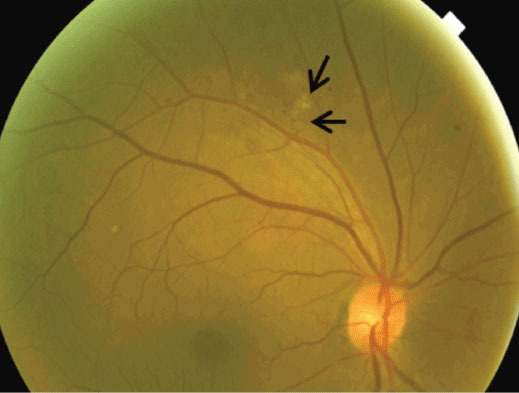 |
| Retina micro-vasculopathy has been shown in this study to be more likely to present in patients with COVID-19. Photo: Gurpinderjeet Kaur, OD. Click image to enlarge. |
There is growing evidence for a variety of complications that follow infection in cases of SARS-CoV-2. While the disease primarily attacks and impairs the function of the respiratory system, neither the back nor front of the eyes are spared; research has suggested that thromboembolic complications may present in up to 30% of patients who contracted COVID-19, and anterior segment involvement can manifest as conjunctivitis with the virus being detectable in infected patients’ tears and conjunctival tissue. When examining posterior segment manifestations of the disease, the researchers found a significantly higher likelihood of retinal micro-vasculopathy in patients with COVID-19.
The pooled analysis included a total of 1,373 subjects from 31 studies, 972 of whom were infected with COVID-19 and had reported retinal vascular changes; the remaining 401 were controls.
Overall, the results demonstrated that clinically recognizable ocular involvement is associated with SARS-CoV-2 infection in not only the anterior but also the posterior segment of the eye. The most common retinal features reported across the various studies included cotton wool spot, microhemorrhages and venous tortuosity.
“The pooled analysis of the literature to date shows that COVID-19 infection is associated with an 8.86 fold retinal microvasculopathy prevalence,” the researchers wrote in their paper. “This is further supported the pooled analysis showing reduced parafoveal vascular density and increased foveal avascular zone in eyes of subjects with COVID-19 infection compared to non-infected controls. Our findings suggest that COVID-19 infection appears to result in sub-clinical microvascular damage which manifests in the retina microcirculation (detected on OCT-A) and is a continuation of a spectrum that can result in clinically detectable features of microvasculopathy (as seen as retinal hemorrhages and cotton wool spots).”
It is important to note that COVID-19 patients do tend to be older and have more co-morbidities such as hypertension and diabetes; however, the study authors write that the inclusion of controls in the study helps to validate retina micro-vasculopathy as an ocular feature of COVID-19, even in patients who reported to be asymptomatic.
“We suggest that in addition to clinical examination, OCT-A, with its ability to assess the retina microvasculature to a high degree of accuracy, be considered the imaging modality of choice when assessing the posterior segment in this condition,” the researchers conclude.
Teo KYC, Invernizzi A, Staurenghi G, et al. COVID-19 related retinal micro-vasculopathy—a review of current evidence. Am J Ophthalmol. September 17, 2021. [Epub ahead of print]. |

